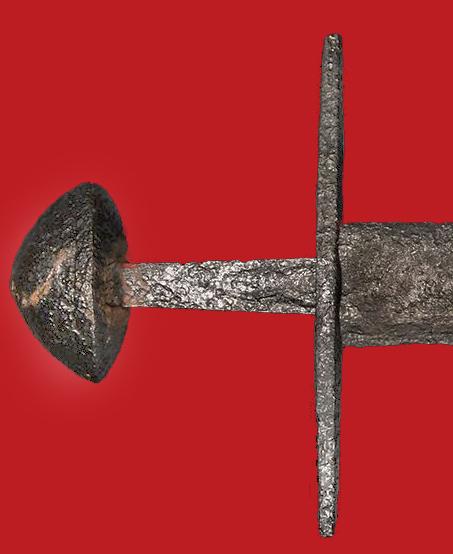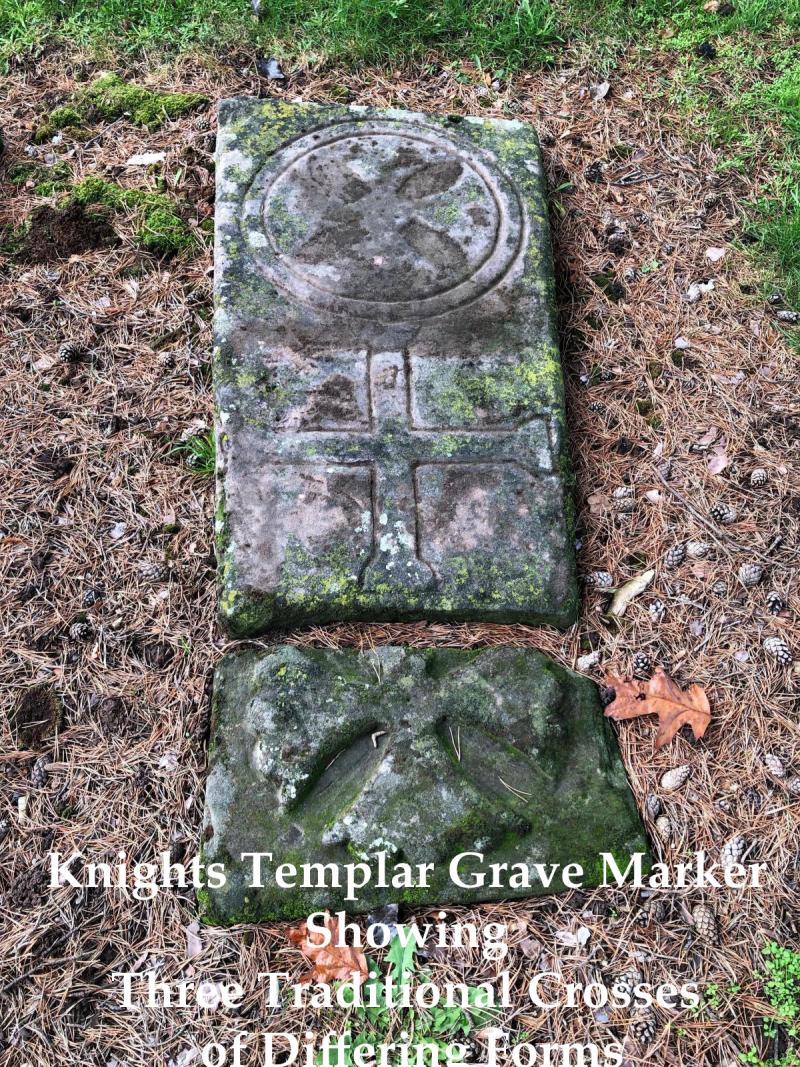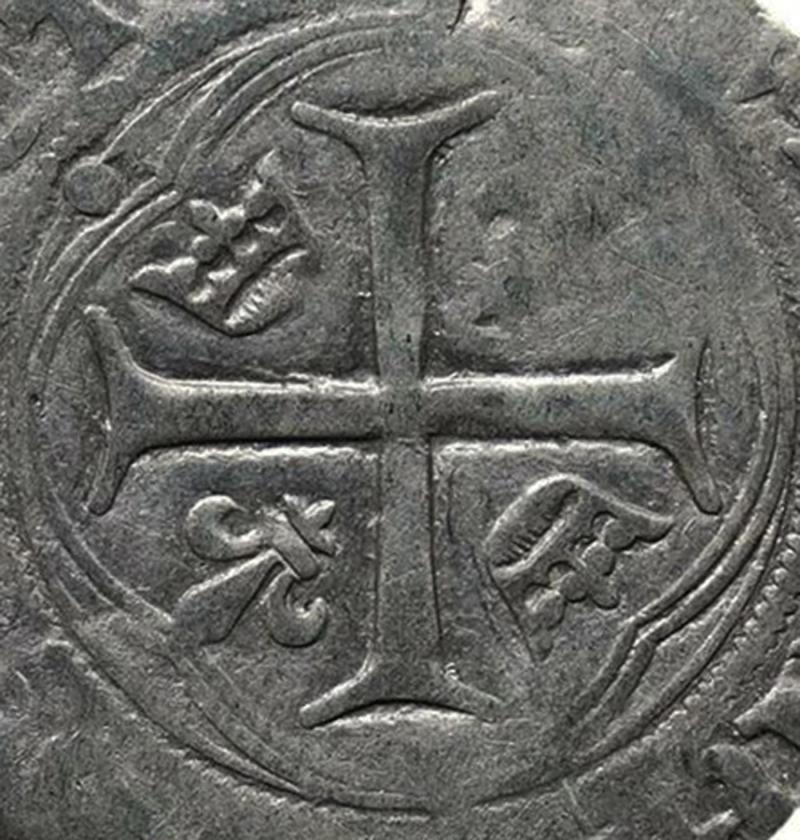NOW SOLD. A Magnificent & Incredibly Rare, Historical, Original, Ancient Sword of a Knights Templar, Bearing Three Knights Templar Armourer's Stamps on Both Sides of The Very Wide & Substantially Powerful & Sharp Blade. Almost 1000 Years Old
A fabulous sword of the 1000's to the 1200's made for and used by a Knights Templar crusader almost 1000 years ago. A form of sword designated in the seminal work by Ewart Oakshott known within the Oakshott categorisation as the type Xa or XI and pommel Oakshott type B. Interestingly, it is further almost identical to the legendary historical sword of St Maurice, the coronation sword of the Holy Roman Emperors
These are incredibly rare identification Knights templar crucifix marks, inlaid with gold alloy traces, and very rare indeed to see on any surviving knight's sword from the Crusades period. We have spent many decades eagerly hunting out such beautiful historic rarities, and remarkably we have been successful in our diligent efforts twice this year, however it is not unusual to go years or even decades without finding any quite like them at all.
There is a similar sword dated to circa 1200, from Germany, preserved in the Wallace collection, in London, and another in the Ewart Oakshott Collection dating from the 11th century
There was a Templar's grave site recently uncovered at a church in Staffordshire, and we show in the gallery the grave marker of a Templar outside the church, showing the tradition of three versions of the Templar crosses carved upon the stone, and this sword also bears the three Templar crosses.
This wonderful original Medieval period antiquity would make a spectacular centrepiece to any new or long established fine collection, or indeed a magnificent solitary work of historical art, for any type of decor both traditional or contemporary. What a fabulous original ‘statement piece’ for any collection or decor. In the world of collecting there is so little remaining in the world from this highly significant era in European and British history. And to be able to own and display such an iconic original representation from this time is nothing short of a remarkable privilege. A wonderful example piece, from the ancient knightly age. Effectively, from this time of almost a thousand years ago, from a collectors point of view, nothing else significant survives at all, only the odd small coin, ring, or very rarely seen, and almost impossible to own, carved statuary.
A Single-Handed, Knights Templar sword, made in the 12th century {circa 1100's} and constantly used in the early Crusades period, by a Knights Templar. with a very broad, and still incredibly sharp, tapering blade bearing six armourers stamps of the Knights Templars, it has it original, long, now mobile cruciform crossguard. Original ancient iron swords, if they still have a crossguard, never have the original wooden grips, the wood never survives the hundreds of years passing which means, the crossguard becomes mobile and no longer in a fixed position.
Hand forged by such as a templar armourer, during the time of England's King Henry Ist, and used into the reigns of King Henry the IInd, and King Richard Ist, aka the Lionheart, and potentially, for the following century.
The Knights Templar were an elite fighting force of their day, highly trained, well-equipped, and highly motivated; one of the tenets of their religious order was that they were forbidden from retreating in battle, unless outnumbered three to one, and even then only by order of their commander, or if the Templar flag went down. Not all Knights Templar were warriors. The mission of most of the members was one of support – to acquire resources which could be used to fund and equip the small percentage of members who were fighting on the front lines. There were actually three classes within the orders. The highest class was the knight. When a candidate was sworn into the order, they made the knight a monk. They wore white robes. The knights could hold no property and receive no private letters. They could not be married or betrothed and could not have any vow in any other Order. They could not have debt more than they could pay, and no infirmities. The Templar priest class was similar to the modern day military chaplain. Wearing green robes, they conducted religious services, led prayers, and were assigned record keeping and letter writing. They always wore gloves, unless they were giving Holy Communion. The mounted men-at-arms represented the most common class, and they were called "brothers". They were usually assigned two horses each and held many positions, including guard, steward, squire or other support vocations. As the main support staff, they wore black or brown robes and were partially garbed in chain mail or plate mail. The armour was not as complete as the knights. Because of this infrastructure, the warriors were well-trained and very well armed. Even their horses were trained to fight in combat, fully armoured. The combination of soldier and monk was also a powerful one, as to the Templar knights, martyrdom in battle was one of the most glorious ways to die.
The Templars were also shrewd tacticians, following the dream of Saint Bernard who had declared that a small force, under the right conditions, could defeat a much larger enemy. One of the key battles in which this was demonstrated was in 1177, at the Battle of Montgisard. The famous Muslim military leader Saladin was attempting to push toward Jerusalem from the south, with a force of 26,000 soldiers. He had pinned the forces of Jerusalem's King Baldwin IV, about 500 knights and their supporters, near the coast, at Ascalon. Eighty Templar knights and their own entourage attempted to reinforce. They met Saladin's troops at Gaza, but were considered too small a force to be worth fighting, so Saladin turned his back on them and headed with his army towards Jerusalem.
Once Saladin and his army had moved on, the Templars were able to join King Baldwin's forces, and together they proceeded north along the coast. Saladin had made a key mistake at that point – instead of keeping his forces together, he permitted his army to temporarily spread out and pillage various villages on their way to Jerusalem. The Templars took advantage of this low state of readiness to launch a surprise ambush directly against Saladin and his bodyguard, at Montgisard near Ramla. Saladin's army was spread too thin to adequately defend themselves, and he and his forces were forced to fight a losing battle as they retreated back to the south, ending up with only a tenth of their original number. The battle was not the final one with Saladin, but it bought a year of peace for the Kingdom of Jerusalem, and the victory became a heroic legend.
Another key tactic of the Templars was that of the "squadron charge". A small group of knights and their heavily armed warhorses would gather into a tight unit which would gallop full speed at the enemy lines, with a determination and force of will that made it clear that they would rather commit suicide than fall back. This terrifying onslaught would frequently have the desired result of breaking a hole in the enemy lines, thereby giving the other Crusader forces an advantage.
The Templars, though relatively small in number, routinely joined other armies in key battles. They would be the force that would ram through the enemy's front lines at the beginning of a battle, or the fighters that would protect the army from the rear. They fought alongside King Louis VII of France, and King Richard I of England.3 In addition to battles in Palestine, members of the Order also fought in the Spanish and Portuguese Reconquista.
According to author S.Tibble, and in his new book, Templars, the Knights Who Made Britain, he details a very convincing and gripping history, that the Templars, famous for their battles on Christendom’s eastern front, were in fact dedicated peace-mongers at home. They influenced royal strategy and policy, created financial structures, and brokered international peace treaties—primarily to ensure that men, money, and material could be transferred more readily to the east.
Charting the rise of the Order under Henry I through to its violent suppression following the fall of Acre, Tibble argues that these medieval knights were essential to the emergence of an early English state. Revealing the true legacy of the British Templars, he shows how a small group helped shape medieval Britain while simultaneously fighting in the name of the Christian Middle East
The Oakshott Type XI swords were distinguished by Oakeshott by having a double edged blade, generally long in proportion to the hilt, with a very fuller running within a few inches of the point. This type has generally been considered to belong to the period of c. 1120-c./1200–1220 AD, but research following the work of Oakeshott has given a much earlier possible date of employment and confirmed that the sword was still used during the fourteenth century. Since swords of this typology were often discovered in rivers or buried, due to the corrosion, they present spatulate or slightly rounded points. Crossguard is mobile on this sword, as usual, as no wooden grip ever survives.
Almost every weapon that has survived today from this era is now in a fully russetted condition, as is this one, because only the swords of kings, that have been preserved in national or Royal collections are today still in a relatively good state and condition. However, compared to many currently in the Royal Collection this could be considered fine and above average.
In the gallery we show a Templar cross on a Templar silver coin, and a photo of the three Templar crosses on a Templar grave, versions as can be clearly seen on this blade.
With reference to;
Templars
The Knights Who Made Britain
Steve Tibble
Imprint: Yale University Press, to be Published: 12 September 2023
34.25 inch blade, total 39.75 inches
As with all our items it comes complete with our certificate of authenticity
Code: 24916










